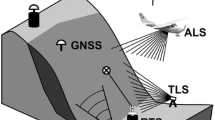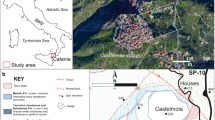Abstract
Rock cliff monitoring to evaluate related rockfall hazard requires a deep knowledge of the geometry and kinematics of the rock mass and a real-time survey of some key features. If a sedimentary rock system has sloping discontinuity planes, an open joint could become a potential sliding surface and its conditions must be monitored. It is the case of the Passo della Morte landslide (Carnic Alps, Northeastern Italy), where sub-vertical joints exist. Remote sensing techniques such as terrestrial laser scanning (TLS) and infrared thermography (IRT) allow a fast and efficient contactless geometrical and geomechanical examination of a rock mass. Therefore, they can be used to recognize those joints that require monitoring with on-site instrumentation such as extensometers and/or inclinometers, or also acoustic emission sensors, aiding the arrangement of monitoring systems which are generally quite expensive to install. Repeated IRT surveys would provide useful information about the evolution of unstable slopes, thus suggesting how the on-site monitoring system could be improved. Moreover, data gathered by TLS and IRT can be directly used in landslide hazard assessment. In the test site, an open joint was recognized together with a fair joint that could change in the next future. The results were validated by means of extensometer data.






Similar content being viewed by others
References
Arosio D, Longoni L, Papini M, Scaioni M, Zanzi L, Alba M (2009) Towards rockfall forecasting through observing deformations and listening to microseismic emissions. Nat Hazards Earth Syst Sci 9(4):1119–1131
Budetta P (2010) Application of the Swiss Federal Guidelines on rock fall hazard: a case study in the Cilento region (Southern Italy). Landslides 8(3):381–389
Cai M, Morioka H, Kaiser P, Tasaka Y, Kurose H, Minami M, Maejima T (2007) Back-analysis of rock mass strength parameters using AE monitoring data. Int J Rock Mech Min Sci 44(4):538–549
Codeglia D (2011) Analisi geomeccanica e predisposizione di un sistema di monitoraggio lungo la galleria del Passo della Morte. Master’s Degree Thesis, Trieste University (in Italian)
Corominas J, Moya J, Lloreta A, Gili JA, Angeli MG, Pasuto A, Silvano S (2000) Measurement of landslide displacements using a wire extensometer. Eng Geol 55(3):149–166
Corominas J, Copons R, Moya J, Vilaplana JM, Altimir J, Amigó J (2005) Quantitative assessment of the residual risk in a rockfall protected area. Landslides 2(4):343–357
Deparis J, Garambois S, Hantz D (2007) On the potential of Ground Penetrating Radar to help rock fall hazard assessment: a case study of a limestone slab, Gorges de la Bourne (French Alps). Eng Geol 94(1–2):89–102
Dixon N, Spriggs M (2007) Quantification of slope displacement rates using acoustic emission monitoring. Can Geotech J 44(6):966–976
Dixon N, Spriggs M, Marcato G, Pasuto A (2012) Landslide hazard evaluation by means of several monitoring techniques, including an acoustic emission sensor. In: Eberhardt E, Froese C, Turner K, Leroueil S (eds) Landslides and engineered slopes. CRC Press, London, pp 1405–1411
FLIR (2014a) FLIR ThermaCAM T620 technical datasheet. http://www.flir.com/cs/emea/en/view/?id=41437. Accessed 24 Nov 2014
FLIR (2014b) FLIR QuickReport freeware download page. http://www.flir.com/thermography/eurasia/en/content/?id=11368. Accessed 24 Nov 2014
Franceschi M, Teza G, Preto N, Pesci A, Galgaro A, Girardi S (2009) Discrimination between marls and limestones using intensity data from terrestrial laser scanner. ISPRS J Photogramm Remote Sens 64(6):522–528
Hack R (2000) Geophysics for slope stability. Surv Geophys 21:423–448
Innovmetric (2014) Innovmetric PolyWorks software description. http://www.innovmetric.com/polyworks/3D-scanners/home.aspx. Accessed 24 Nov 2014
Maldague X (2001) Nondestructive evaluation of materials by infrared thermography. John Wiley, Chichester
Marcato G (2007) Valutazione della pericolosità da frana in località Passo della Morte (UD) (Evaluation of landslide hazard in Passo della Morte, Udine). PhD Dissertation, Modena and Reggio Emilia University (in Italian)
Monegato G, Vezzoli G (2011) Post-Messinian drainage changes triggered by tectonic and climatic events (Eastern Southern Alps, Italy). Sedim Geol 239:188–198
OGS (2014) The Friuli Venezia Giulia seismometric network home page. http://www.crs.inogs.it/bollettino/RSFVG/RSFVG.en.html. Accessed 24 Nov 2014
Omar M, Hassan MI, Saito K, Alloo R (2005) IR self-referencing thermography for detection of in-depth defects. Infrared Phys Technol 46(4):283–289
Oppikofer T, Jaboyedoff M, Blikra L, Derron M (2009) Characterization and monitoring of the Åknes rockslide using terrestrial laser scanning. Nat Haz Earth Syst Sci 9:1003–1019
Optech (2014) Optech ILRIS-3D technical data. http://www.optech.com/index.php/product/optech-ilris-scan/. Accessed 24 Nov 2014
Pesci A, Teza G, Bonali E (2011) Terrestrial laser scanner resolution: numerical simulations and experiments on spatial sampling optimization. Remote Sens 3(1):167–184
Pisa G (1972) Tentativo di ricostruzione paleoambientale e paleostrutturale dei depositi di piattaforma carbonatica medio-triassica delle Alpi Carniche sud-occidentali. Mem Soc Geol It 13:35–83 in Italian
Schenato L, Palmieri L, Autizi E, Calzavara F, Vianello L, Teza G, Marcato G, Sassi R, Pasuto A, Galgaro A, Galtarossa A (2013) Rockfall precursor detection based on rock fracturing monitoring by means of optical fibre sensors. Int J Sust Mater Struct Sys 1(2):123–141
Singhroy V, Molch K (2004) Characterizing and monitoring rockslides from SAR techniques. Adv Space Res 33(3):290–295
Slob S, van Knapen B, Hack R, Turner K, Kemeny J (2005) A method for automated discontinuity analysis of rock slopes. Transport Res Rec 1913(1):187–208
Spampinato L, Calvari S, Oppenheimer C, Boschi E (2011) Volcano surveillance using infrared cameras. Earth-Sci Rev 106:63–91
Sturzenegger M, Stead D (2009) Close-range terrestrial digital photogrammetry and terrestrial laser scanning for discontinuity characterization on rock cuts. Eng Geol 106(3–4):163–182
Teza G (2014) THIMRAN: a MATLAB toolbox for thermal image processing aimed at damage recognition in large bodies. J Comput Civil Eng 28(4, 04014017):1–8
Teza G, Pesci A, Genevois R, Galgaro A (2008) Characterization of landslide ground surface kinematics from terrestrial laser scanning and strain field computation. Geomorphology 97(3–4):424–437
Teza G, Marcato G, Castelli E, Galgaro A (2012) IRTROCK: a MATLAB toolbox for contactless recognition of surface and shallow weakness of a rock cliff by infrared thermography. Comput Geosci 45:109–118
Viero A, Teza G, Massironi M, Jaboyedoff M, Galgaro A (2010) Laser scanning based recognition of rotational movements on a deep seated gravitational instability: the Cinque Torri case (North-Eastern Italian Alps). Geomorphology 122:191–204
Walter M, Schwaderer U, Joswig M (2012) Seismic monitoring of precursory fracture signals from a destructive rockfall in the Vorarlberg Alps, Austria. Nat Hazards Earth Sys Sci 12(11):3545–3555
Wu JH, Lin HM, Lee DH, Fang SC (2005) Integrity assessment of rock mass behind the shotcreted slope using thermography. Eng Geol 80(1–2):164–173
Acknowledgments
This work was supported by Fondazione Cariparo within the SMILAND (Innovative integrated Systems for Monitoring and assessment of high rIsk LANDslides) Research Project (Progetto di Eccellenza 2008–2009). The laser scanner data were kindly provided by Michele Potleca (Protezione Civile of Regione Autonoma Friuli Venezia Giulia). Moreover, the authors would like to thank the Regione Autonoma Friuli Venezia Giulia for the aerial laser scanner data and the authorization to reproduction of a map belonging to the Carta Tecnica Numerica Regionale.
Author information
Authors and Affiliations
Corresponding author
Rights and permissions
About this article
Cite this article
Teza, G., Marcato, G., Pasuto, A. et al. Integration of laser scanning and thermal imaging in monitoring optimization and assessment of rockfall hazard: a case history in the Carnic Alps (Northeastern Italy). Nat Hazards 76, 1535–1549 (2015). https://doi.org/10.1007/s11069-014-1545-1
Received:
Accepted:
Published:
Issue Date:
DOI: https://doi.org/10.1007/s11069-014-1545-1




